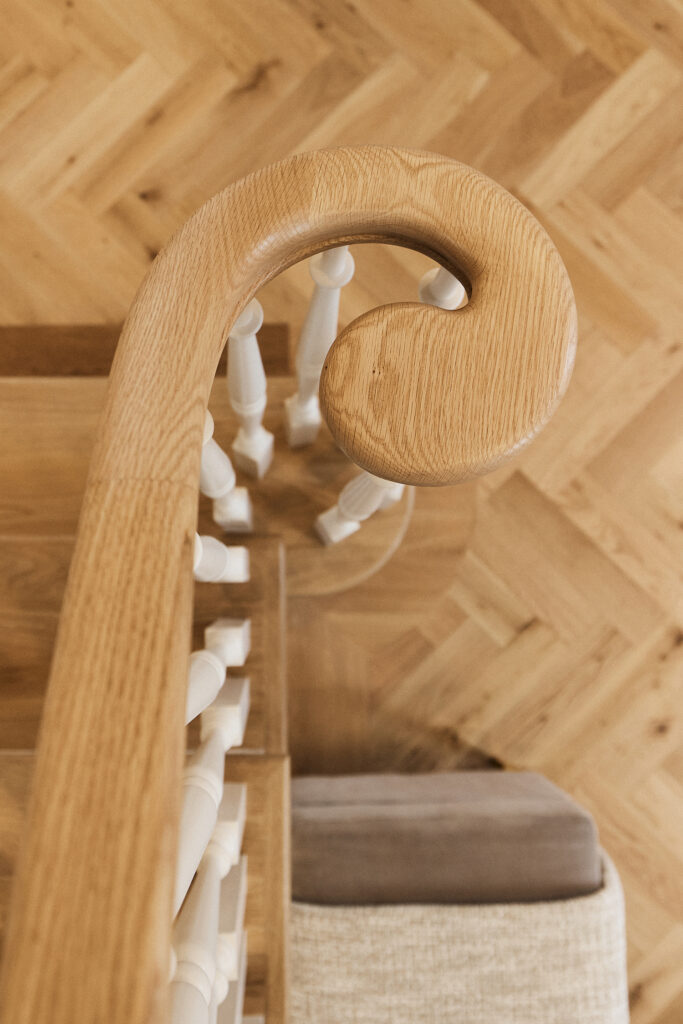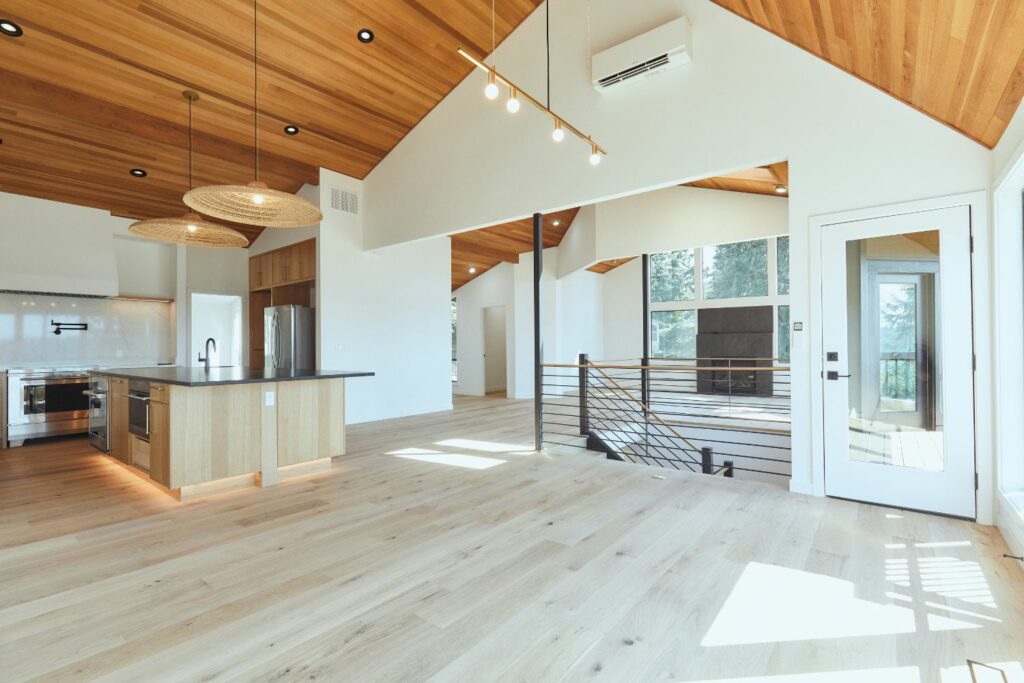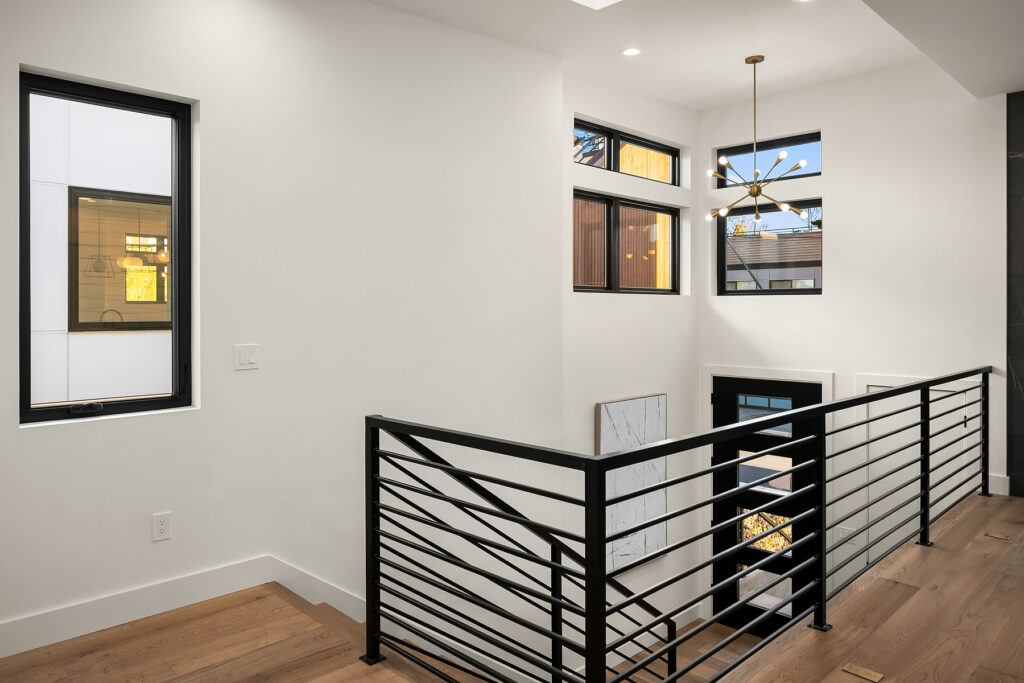When designing a staircase for your home, it’s essential to consider its functionality and the impact on your home’s layout. Before choosing your staircase design, evaluate your budget, family lifestyle, and the space available. While a grand staircase might be appealing, the space you have may call for more practical options.
And we can’t stop here! Once you’ve assessed these factors, you can move on to selecting materials and integrating elements like treads, risers, railings, handrails, and posts to create a beautiful and cohesive design.
In this blog we will discuss some key features of recent 7 staircase designs that we created and built to give you some great inspiration. Are you ready?
1. Contemporary Wood Staircase Design with Open Risers

Floating stairs with open risers are a popular choice for modern homes. In cities like Seattle, where space and light are treasured, these staircases can transform a home. It might be the perfect staircase design option for your Seattle home. These staircases can enhance both style and function.
Floating stairs are renowned for their elegant, minimalist look. Unlike conventional staircases, they give the illusion of steps suspended in mid-air. This design creates a striking visual impact, perfect for those who appreciate contemporary architecture.
Seattle homeowners often face the challenge of maximizing natural light. The open risers in floating staircases allow light to flow freely between each step. This design is ideal for homes where daylight is lacking, amplifying the sense of openness and brightness within your living space.
While floating stairs are undeniably stylish, it’s crucial to balance design with practicality and safety. Homeowners might be tempted to forgo handrails and balusters for a truly open floor look, but safety should never be compromised.
Installing discreet glass railings can maintain the open feel while providing necessary support and safety. Similarly, using non-slip materials on the treads can ensure each step is safe without detracting from the staircase’s elegance.
It’s essential to work with experienced designers and builders who understand the importance of safety in staircase design. They can help you achieve your desired look without sacrificing practical considerations.
2. Modern Staircase Design with Mono Stringer and Custom Square Bullnose

The stringer is an essential component of any staircase, providing the structural support for the treads and risers. There are several types of stringers, but the mono stringer has gained popularity for its unique benefits.
Mono Stringer
The mono stringer is a single beam that runs down the center of the staircase (see below), supporting each step. Its simplistic yet robust design that adds a contemporary twist to traditional staircases. With a mono stringer, you achieve a floating step effect. This design is ideal for homeowners who want a statement piece staircase.

In staircase design, the bullnose refers to the rounded or squared edge of a first step. Traditionally, it’s been used to support the newel post, the central pillar of a staircase. However, in modern design, the bullnose has evolved to become a beautiful architectural feature.
Custom Square Bullnose
The custom square bullnose is a modern take on the traditional rounded design. It offers a crisp, angular finish that complements contemporary interiors. This squared edge aligns perfectly with the clean lines of modern decor. It’s a small detail that makes a significant visual impact.
3. Wood and White Staircase Design with Bullnose and Left Hand Volute
We are bringing this elegant design concept of white and wood into the spotlight. This classic 180-degree turn staircase proudly carries the elements of colonial revival style with a bullnose and left-hand volute.
Colonial revival style known for its graceful and refined features. Typically characterized by its attention to detail and symmetry. This style tends to harmonize beautifully with modern and traditional homes alike. Perfectly suited for homeowners who are not seeking modern feels but rather appreciate the authentic familiar yet sophisticated design.
A left-hand volute at the base of the staircase is more than just a beautiful architectural feature; it’s a statement of luxury. The volute, which is the coiled end of a handrail, creates an inviting entry point to your staircase.

Its circular shape draws the eye and sets a tone of elegance, hinting at the colonial revival style that’s both timeless and sophisticated. Unlike traditional newel posts, the volute offers a seamless transition that enhances the fluidity of the staircase.
According to general safety guidelines for staircases, the gaps between balusters shouldn’t exceed four inches. Here, the design elegantly incorporates three balusters per step, ensuring not only safety but also visual balance.

4. Natural Wood Tones and Mixed Materials
Natural wood tones are making a strong comeback in modern home design, offering warmth and inviting aesthetics that other materials can’t match. When designing a staircase, consider using various wood species for visual interest by varying grain patterns, finishes, and ensuring scale and proportion for harmony.
Mixing materials is another trending approach, allowing for unique designs by combining wood with metal for an industrial vibe, glass with steel for a modern feel, or stone with wood for a rustic touch.

5. Rod Railing System
Horizontal rod railings have several advantages over vertical railings. First of all, they create unobstructed views and open up a space that vertical railings may block. This makes any space feel larger and more connected.
Horizontal railings don’t require balusters, which makes them less labor intensive and easier to install than vertical railings. They also allow for more flexibility in determining the height of the railing.
Horizontal railings are generally more affordable than vertical railings because they require fewer connections and less building material.

Horizontal railings can work well for homes with wide open panoramas, such as mountains, lakes, or fields.
They will also look great in large, wide backyards with seating areas.
If you are choosing between rod and cable railing, always remember, that rod railing is stronger and more durable than cable railing. It is easier to clean and maintain.
Take a look at this modern 180-degree turn staircase with rod railing and mono stringer. In this open floor concept, designer combined metal rods with wooden handrails for a warm, inviting look.

Photo Credit: construction2style
6. Stainless Steel Black Flat Handrail
When it comes to modern home design, a staircase with a stainless steel black flat handrail is a game-changer. This minimalist design creates a clean look and will complement any furniture and lighting. Whether in a residential or commercial setting, these handrails make a bold statement.
Another key feature of this handrail design is its ability to create a clean and visually expansive environment. The horizontal rods help elongate the visual line of sight, making spaces appear larger and more open. This is particularly beneficial in smaller areas, where maximizing space is crucial. The black finish adds a touch of luxury without overpowering the existing decor.

7. Horizontal Stair Railing with Elegant Wall Step Lights
This 90-degree turn staircase is complemented by accent lighting, which is lighting that accentuates a particular area, in this case, stairs.
For open riser staircases, try adding LED recessed lights on the wall. Space the lights evenly apart, be consistent and strategic to ensure even coverage.
When deciding on the amount of lights needed, consider spacing them approximately 2-3 feet apart.


Our main goal was to give you some great staircase design ideas and get you excited to start dreaming and even creating your own staircase. We hope we’ve achieved that. Visit us at Alair Homes in Kirkland for more information or schedule a consultation.
